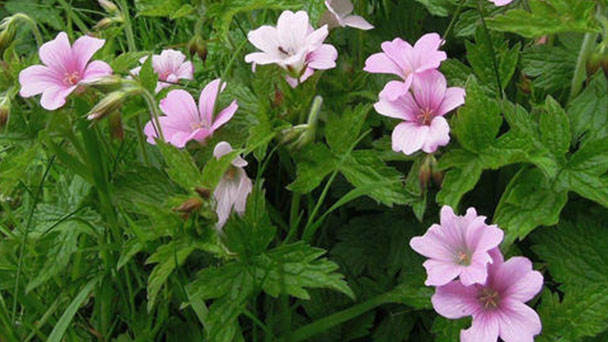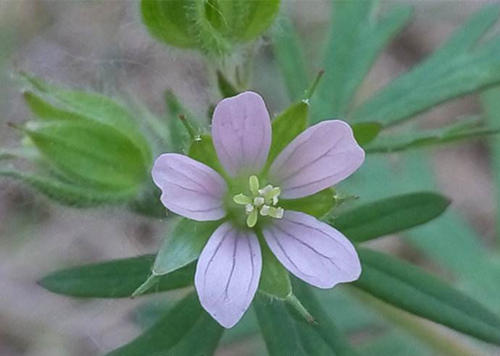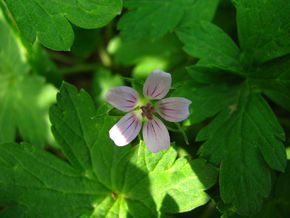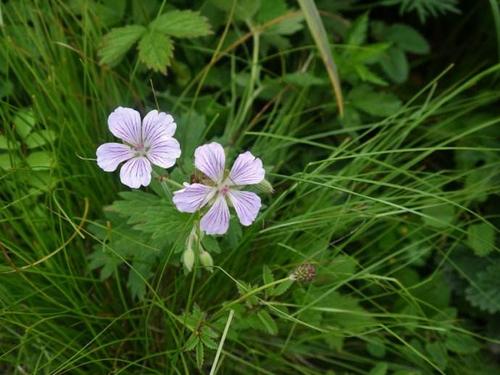Geranium (Cranes-bill) profile
Written by Maggie
Feb 24 2021

Crane's-bill is the dry ground part of the plant Hexaerophilous Plant, Crane's-bill or Wild Crane's-bill. Crane's-bill fruit is harvested near ripe in summer and autumn, bale and dried in the sun.
Crane's-bill picture

Crane's- Bill's ecological habits
Crane 's-Bill likes warm and humid climates, and can withstand cold and moisture. Crane's-bill likes full sunshine. Loose and fertile, moist loam is suitable for planting.
Crane's Bill was born on hillsides, meadows, ridges, roadsides and near village houses.
2, plain roadside and under the woods.
3, born in the river bank, wetlands, forests, forests, roadside and mountain.
Born in the wet hillside, roadside, fields, weeds.
Crane's- Bill growing methods
Crane 's-Bill likes warm and humid climates, and can withstand cold and moisture. Crane's-bill likes full sunshine. Loose and fertile, moist loam is suitable for planting.
Field management
Crane's- Bill seedlings should be ploughed, weeding, topdressing human excrement and urine, winter seedlings after the removal of dead plants and residual leaves, soil, manure, compost, etc.
Harvesting and storage
Summer, autumn fruit will be ripe, cut off the ground part or the whole Crane's-bill to pull up, to clean the soil and impurities, dry.
Crane's- Bill' propagation methods
Roots division
Dig the old roots of Crane's-bill from the time the seedlings fall in winter to the time when they sprout in early spring, and cut them into several pieces, each with buds. Open holes according to the row spacing of 25cm×25cm, plant 1 hole in each hole, cover with soil compacted, and water.

Crane's- Bill species classification
1. Geraniaceae
Geraniaceae is an annual or biennial herb, 10-50cm tall. The root is cylindrical. Stem is tiled ground or oblique ascending, much branched, pilose.Leaves opposite; Petiole is 4-6cm long; Stipules are lanceolate, margin 5 -- 10mm membranous; Leaf blade is oblong-ovate or oblong-triangular, 4 -- 6 x 3 -- 4cm, pinnately lobed, pinnacles 5 -- 9 pairs, basally descending, pinnules banate, entire or L-3 coarsely dentate, two mask pubescent. Inflorescences are umbels, axillary; Pedicels are 5 -- 15cm long, usually 2-5 flowered, pedicels 1 -- 3cm long; Sepals are oblong, apex acuminate, awn 2 -- 3cm long; Petals 5, obovate, lavender or bluish purple, subequal to sepals, apex obtuse, base covered with white hairs; The stamens were 10,2 circles, 5 of the outer circles were drug free, 5 of the inner circles were drug free, 5 of the nectaries were 5; Ovary densely white villous. Capsule, 3 -- 4cm long, apex with a long beak, 5 fruit petals separated from the central axis at maturity, beak spirally twisted, with brown hairs on the inside.
2. Crane's- Bill in Siberia
Crane's- Bill in Siberia is a perennial herb, 20-100cm tall. Roots are erect, branched or unbranched, usually simple, sparse 2-3. Stems are slender, prostrate or upper oblique upward, much branched, slightly inverted hairy. Leaves are opposite; Basal leaves and lower cauline leaves long petiolate, apical petiolate short, petiolate obtusely pubescent or accentuated; Stipules are lanceolate, long acuminate; Basal leaves are early withered, homomorphic to cauline leaves, reniform pentagonal, base broadly cordate, 3 -- 6cm long and 4 -- 8cm wide, palmately 5-lobed, lobes obovate or narrowly obovate, base cuneate, upper pinnately divided or dentate with deep notches; Upper leaf 3 deep lobes, upper and lower on both sides of the sparse accumulation of hair, below along the veins of hair more dense. Flowers are usually solitary axillary; Pedicle 4 -- 5cm long, filiform, obliquely pilose or obliquely pilose, with 2-lanceolate bracts near middle, obliquely puberulent, laterally curved in fruit; epals oblong-lanceolate, ca. 4mm long, margin membranous; Petals reddish or white with purple veins, nearly as long as sepals. Capsule is 1.5-2cm long, puberulent.Flowering period from June to July, fruiting period from July to September.
3. Crane's- Bill Nepal
Crane's- Bill Nepal is a perennial herb, 30-50cm or taller, sometimes stunted. Roots are slender, oblique. Stems are thin, spread on the ground, inclined to rise, nearly square, often inverted sparsely pubescent. Leaves are opposite; Pedicle of lower cauline leaves longer than leaf blade; Stipules are narrowly lanceolate to lanceolate, 0.4-1cm long, apex acuminate; Leaf blade reniform pentagonal, 2 -- 5cm long, 3 -- 5cm wide; 3-5 lobes not reaching base, lobes broadly ovate, margin dentate notched or lobed, with sparsely overlying hairs and sparsely pubescent below. Cymes have several, axillary, each with 2 flowers, sometimes 1 flower; Pedicels are 2 -- 8cm long. Bracteate, obliquely pilose, laterally curved in fruit; Sepals are lanceolate, ca. 0.6cm long, apex acuminate, margin membranous, abaxially 3-veined, with long white hairs along veins; Petals are small, purplish red, slightly longer than sepals; Filaments are proximally ovate, anthers suborbicular, purplish red; Ovary is green, stigma purplish red, all covered with white hairs. Capsule ca. is 1.7cm, pilose.
4. Geranium transversale
Geranium transversale is a perennial herb, 20-60cm tall. The rhizome is short, erect, with a cluster of long fusiform fleshy root tubers at the lower end.Stem erect, subglabrous, often bifid branching. Leaves are opposite; Lower cauline leaves are petiolate, 10 -- 15cm long, tapering upward, apical leaves sessile; Stipules are lanceolate or ovate, apex acuminate, 5-10mm long; Leaf blade is reniform orbicular, 3 -- 4cm long and 5 -- 7cm wide, palmately 7-lobed to base, lobes rhomboid ovate or lanceolate, irregularly pinnated; Lobes are lanceolate or linear-elliptic, 2 -- 3mm wide, acute, upper and margin densely appressed white hairs, sparsely growing hairs below. Inflorescences are axillary or terminal, stalks 3 -- 6cm long, slender, usually 2-flowered; Pedicle filiform, 2 -- 3cm long, obsparsely puberulent, curved upward in fruit apically; Bracts are lanceolate, long acuminate; Sepals are ovate, subglabrous; Petals are lavender, ca. 7 -- 12mm; Filaments base enlarged part ciliate. Capsules are hairy, 1.2-2cm long.
Crane's Bill's distribution
Crane's Bill is distributed in Northeast, North, East, Central China, Shaanxi, Gansu and Sichuan provinces. Russia Far East, Korea and Japan are distributed.
Crane's Bill medicinal value
Chinese medicine Crane's Bill has remarkable curative effect on rheumatism, so the old stork's plaster and Crane's Bill external plaster used in treating rheumatism have been handed down till now. Crane's-bill is also used as a garden ground cover. Folk prescription has been used to treat hemiplegia.
Crane 's-bill flower language
Crane's- Bill flower language is auspiciousness, joy, vigilance, effort.

Latest Updated
- Benefits of Bugleweed - 7 Science-backed Health Benefits
- Bugleweed Dangers & Side Effects - Is It Poisonous?
- How to Plant Evergreen Trees - What You Should Know
- When to Plant Evergreens - Grow Guide for Evergreen Trees
- 12 Wonderful Evergreen Shrubs for Your Garden
- 12 Popular Evergreen Plants with Pictures for Beginners
- When And How To Prune A Lilac Bush Like a Pro
- How to Grow & Care for Lilac Vine (Hardenbergia Violacea)
- Japanese Lilac Tree (Syringa Reticulata) Care & Propagation Guide
- Shumard Oak Pros and Cons - What to Know
Popular Articles
- Winter maintenance of Antirrhinum Majus
- How to Grow Terminalia Mantaly Tree
- How to Grow and Care for Crossostephium Chinense
- How to grow Antirrhinum Majus in spring
- Peristeria Elata (Dove Orchid) Profile: Info & Care Guide
- Underwatered Snake Plant (Sansevieria Trifasciata) - Signs And How To Fix
- How to Care for Brazilian Jasmine Plant (Mandevilla Sanderi)
- How to Grow & Care for Graptopetalum Purple Delight in Summer
- Rosa Chinensis (China Rose): Plant Growing & Care Tips
- How to Care for Baby Sun Rose (Aptenia Cordifolia)